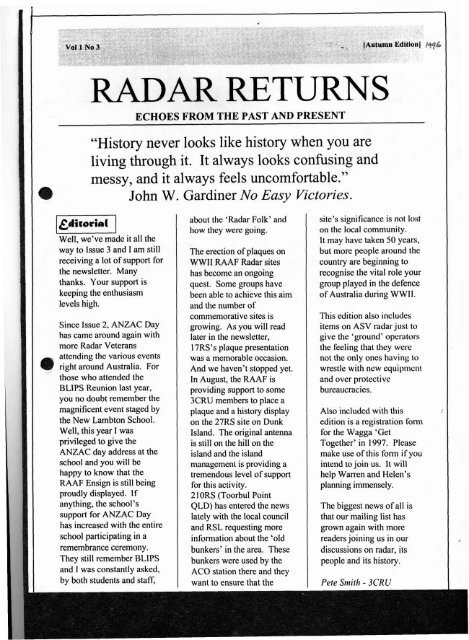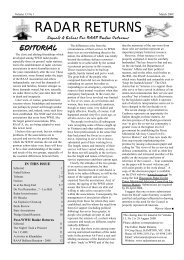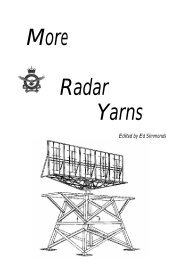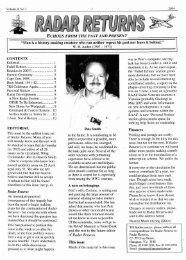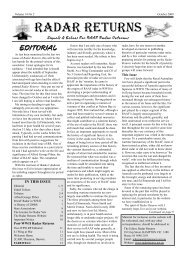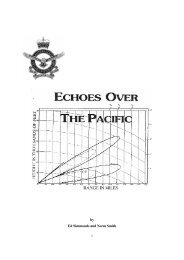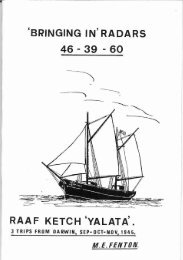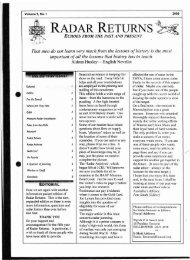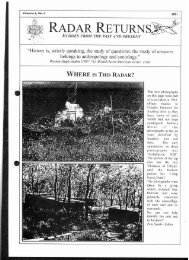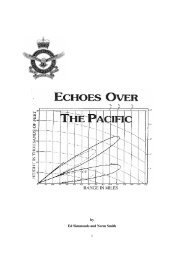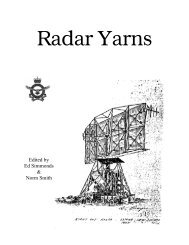You also want an ePaper? Increase the reach of your titles
YUMPU automatically turns print PDFs into web optimized ePapers that Google loves.
I<br />
'<br />
I more<br />
Vol 1 No 3<br />
RADAR RETURNS<br />
ECHOES FROM THE PAST AND PRESENT<br />
"History never looks like history when you are<br />
living through it. It always looks confusing and<br />
messy, and it always feels uncomfortable."<br />
John W. Gardiner No Easy Victories.<br />
Well, we've made it all the<br />
way to Issue 3 and I am still<br />
receiving a lot of support for<br />
the newsletter. Many<br />
thanks. Your support is<br />
keeping the enthusiasm<br />
levels high.<br />
Since Issue 2, ANZAC Day<br />
has came around again with<br />
<strong>Radar</strong> Veterans<br />
attending the various events<br />
right around Australia. For<br />
those who attended the<br />
BLIPS Reunion last year,<br />
you no doubt remember the<br />
magnificent event staged by<br />
the New Lambton School.<br />
Well, this year I was<br />
privileged to give the<br />
ANZAC day address at the<br />
school and you will be<br />
happy to know that the<br />
RAAF Ensign is still being<br />
proudly displayed. If<br />
anything, the school's<br />
support for ANZAC Day<br />
has increased with the entire<br />
school participating in a<br />
remembrance ceremony.<br />
They still remember BLIPS<br />
and I was constantly asked,<br />
by both students and staff,<br />
about the '<strong>Radar</strong> Folk' and<br />
how they were going.<br />
The erection of plaques on<br />
WWII RAAF <strong>Radar</strong> sites<br />
has become an ongoing<br />
quest. Some groups have<br />
been able to achieve this aim<br />
and the number of<br />
commemorative sites is<br />
growing. As you will read<br />
later in the newsletter,<br />
17RS's plaque presentation<br />
was a memorable occasion.<br />
And we haven't stopped yet.<br />
In August, the RAAF is<br />
providing support to some<br />
3CRU members to place a<br />
plaque and a history display<br />
on the 27RS site on Dunk<br />
Island. The original antenna<br />
is still on the hill on the<br />
island and the island<br />
management is providing a<br />
tremendous level of support<br />
for this activity.<br />
2 10RS (Toorbul Point<br />
QLD) has entered the news<br />
lately with the local council<br />
and RSL requesting more<br />
information about the 'old<br />
bunkers' in the area. These<br />
bunkers were used by the<br />
ACO station there and they<br />
want to ensure that the<br />
.* . , . [Autumn Edition1 1qA<br />
site's significance is not lost<br />
on the local community.<br />
It may have taken 50 years,<br />
but more people around the<br />
country are beginning to<br />
recognise the vital role your<br />
group played in the defence<br />
of Australia during WWII.<br />
This edition also includes<br />
items on ASV radar just to<br />
give the 'ground' operators<br />
the feeling that they were<br />
not the only ones having to<br />
wrestle with new cquiptnct~t<br />
and over protective<br />
bureaucracies.<br />
Also included with this I<br />
edition is a registration form<br />
for the Wagga 'Get<br />
Together' in 1997. Please<br />
make use of this form if you<br />
intend to join us. It will<br />
help Warren and Helen's<br />
planning immensely.<br />
The biggest news of all is<br />
that our mailing list has<br />
grown again with more<br />
readers joining us in our<br />
discussions on radar, its<br />
people and its history.<br />
( Pete Smith - 3CRU
)<br />
1<br />
RADAR RETURF(S - 2 - [Autumn Edition]<br />
BURREWARRA POINT<br />
On 20 April this year,<br />
another radar plaque was<br />
unveiled. This plaque<br />
commemorates the service<br />
of 17 <strong>Radar</strong> Station and the<br />
personnel who served there.<br />
It was unveiled by the<br />
Mayor of Eurobodalla Shire,<br />
Councillor Chris Vardon,<br />
and was supported by a<br />
large CI-oss section of the<br />
local business community.<br />
Joining the 15 ex- 17RS<br />
personnel and 50 'radar<br />
friends' were a number of<br />
local people who all enjoyed<br />
a memorable occasion. The<br />
RAAF Historical Section<br />
brought along copies of the<br />
government documents<br />
authorising construction of<br />
the radar site. This<br />
generated a lively discussion<br />
during the dinner,<br />
particularly when Arthur<br />
Veich stated that he<br />
purchased the entire radar at<br />
the end of war for 7 pounds.<br />
A minuscule fraction of its<br />
production cost. As further<br />
proof of this statement, he<br />
produced some original<br />
equipment from 17RS. This<br />
led to a scene which will<br />
remain in the minds of<br />
everyone who attended.<br />
On their hands and knees, in<br />
the car park at 10:30 at<br />
night, were 8 ex- 1 7RS<br />
personnel and a recently<br />
retired RAAF Air<br />
Commodore discussing the<br />
function of a part of the<br />
radar. At the end of the<br />
lively discussion, the<br />
consensus was that it was an<br />
aerial coupling unit from the<br />
radar.<br />
Yet another successful radar<br />
function, with particular<br />
thanks to Maureen and Les<br />
Kinross who were the chief<br />
organisers of the event.<br />
ASV - An Operator's<br />
View<br />
While researching Ted<br />
Dellit's question on ASV<br />
and ASD, I have discovered<br />
that there is even less<br />
written about this facet of<br />
radar than its ground base<br />
relation. I have been<br />
hunting around for a while<br />
but have only come across<br />
technical manuals or<br />
descriptions on its use in<br />
Europe. Nothing about its<br />
employment in the SWPA.<br />
1 did receive a letter from<br />
Roy Lugg (WA) which may<br />
explain why the airborne<br />
arm of radar fared worse<br />
than their ground based<br />
version when it came to<br />
recording its history. He<br />
was a Wireless Air Gunner<br />
(WAG) with 13 Squadron in<br />
Darwin in 1942 when this<br />
incident occurred and his<br />
account is based upon his<br />
flying log entries. It also<br />
indicates that the secrecy<br />
cloud was not restricted to<br />
just one branch of the<br />
service.<br />
"During my absence down<br />
south, two civilians had<br />
arrived at Hughes [airstrip]<br />
and worked on 247 [RAAF<br />
Hudson No A 1 6-2471.<br />
When I arrived back I was<br />
called down to the plane and<br />
introduced to them by<br />
Christian name only. They<br />
then gave me a 'full'<br />
briefing.<br />
Our aircraft had been fitted<br />
out with ASV - the first in<br />
the Territory.<br />
'What's that ?' (I later<br />
found out it stood for 'Anti<br />
Surface Vessel'.)<br />
'We can't tell you. Its<br />
secret. '<br />
'How do you use it ?'<br />
'You switch it on here.'<br />
'What does it do ?'<br />
'Its ASV !'<br />
I gave up. We had heard of<br />
radar equipped night<br />
fighters. The equipment<br />
consisted of a generator,<br />
mounted in the main cabin; a<br />
black box sat on the<br />
Wireless Operator's table<br />
just where he usually put his<br />
pad; and a couple of shiny<br />
rods sticking out of the side<br />
of the aircraft. On the front<br />
of the [black] box was a<br />
sheet of glass with a row of<br />
knobs underneath the glass.<br />
In addition, there was a sort<br />
of rubber face mask that<br />
fitted over the top of the<br />
box so you shut out all the<br />
light while you peered into<br />
the dark. When you<br />
switched it on, a row of<br />
green 'grass' sprang up on<br />
the glass screen. By<br />
twiddling the knobs, while<br />
the 'experts' looked on, I<br />
could make the 'grass' grow<br />
or shrink. I was qualified !<br />
'There you are - that's all<br />
there is to it. Cheerio' said<br />
the experts. I suspect I now<br />
knew as much as they did.<br />
This was secrecy translated<br />
to lunacy. The theory was<br />
that the less I knew, the less<br />
I could tell the enemy if shot<br />
down. Pity we didn't know<br />
a Jap technician in the
)<br />
1<br />
RADAR RETURNS - 3 - [Autumn Edition!<br />
squadron. He might have<br />
been able to show me how<br />
to operate it.<br />
Half the squadron came and<br />
looked at the gadget and<br />
departed shaking their heads<br />
after suggesting what I<br />
should do with it. I was<br />
tempted to.<br />
After a crew conference, we<br />
decided it might work in the<br />
air if it didn't work on the<br />
ground due to the trees. So<br />
we tried that for an hour and<br />
fifteen minutes. With<br />
training, and experience, it<br />
was possible to interpret the<br />
pattern but our efforts were<br />
futile. Our next effort - not<br />
logged - was a few days<br />
later. Ground control<br />
indicated that a Jap night<br />
fighter was wandering<br />
around upstairs.<br />
Holdsworth [WGCDR<br />
Holdsworth CO 13 Sqn]<br />
decided we should see if we<br />
could find it with our ASV.<br />
Lloyd Edwards' (my new<br />
CO) WAG considered it a<br />
lot of fun - chiefly because<br />
of a frantic skipper up front<br />
seeking immortality. Just<br />
more 'grass'. So radar was<br />
set backwards months.<br />
After a further crew<br />
conference, we decided that<br />
the equipment, made in<br />
England, wasn't suitable for<br />
the tropics. Radial engines,<br />
for example, caused less<br />
trouble than 'in line'<br />
engines.<br />
28 Sep 1942<br />
0200hrs A 16-226 PLTOFF<br />
Moore, Moonlight search.<br />
We would have been called<br />
out about I I pm to search<br />
for a submarine or boat on<br />
I<br />
the surface. We flew so we<br />
could search 'up moon'.<br />
The best way to do this is to<br />
fly across the path of the<br />
moonbeams so at least three<br />
crew members could look<br />
for a silhouette. My log<br />
indicates I was a crew<br />
member but I may have been<br />
put in as an extra set of<br />
eyes. There seemed to be<br />
some urgency about this<br />
trip. Saw nothing.<br />
[Over the following weeks a<br />
number of sorties were<br />
attempted in order to get<br />
results with the ASV set.]<br />
6 Oct 1942<br />
0805hrs A 16-247 WGCDR<br />
Holdsworth, Formation<br />
mock raid. Kitty<br />
Interception.<br />
I think this was our last<br />
effort to get any results out<br />
of our ASV."<br />
The above account is not a<br />
generous description of the<br />
advantages of ASV, more a<br />
description of degree of<br />
frustration suffered by early<br />
operators of ASV.<br />
Considering the amount of<br />
training they received, one<br />
has to admire their<br />
persistence.<br />
However, Roy's anecdote is<br />
not all bad news. He also<br />
included the following<br />
comment for all the ground<br />
radar personnel. His<br />
comments illustrate it is<br />
sometimes better not to<br />
know what is going on.<br />
"This a good opportunity to<br />
say 'Thanks' to you chaps<br />
who, so often gave us<br />
warning to get into out slit<br />
trenches safely. On the<br />
other hand, when the sirens<br />
went and you were out in<br />
the middle of the drome and<br />
the nearest trench was a<br />
couple of hundred yards<br />
.away, you caused some<br />
panic. Worse though was<br />
when you were a couple of<br />
hundred kilometres out over<br />
the Timor Sea on the way<br />
home after raiding Koepang<br />
and you would call Darwin<br />
to transmit a coded warning<br />
[but receive] 'Air Raid<br />
Pending - 5 minutes'. We<br />
would be left wondering<br />
whether there would be an<br />
airstrip left to land on, or<br />
worse still, we would run<br />
into half the Jap air force,<br />
complete with fighter cover,<br />
returning to Koepang after<br />
raiding Darwin. We being a<br />
solitary Hudson bomber.'<br />
WAAAF RADAR<br />
MECHANICS<br />
Adding to information so far<br />
received on this topic, 1 '<br />
received a letter from Keith<br />
Weir (QLD).<br />
Accompanying this letter<br />
were the details of a reunion<br />
in July 1996 for anyone who<br />
served at RAAF Station<br />
Maryborough. Within the<br />
list of nominated attendees<br />
are five WAAAF RAD<br />
MECHs. They are Valerie<br />
Callard, Barbara Daly, Joan<br />
Davis, Hazel Holmes and<br />
Ruth Inglis. I don't know if<br />
these are their maiden names<br />
or not. However, it is<br />
further proof that the<br />
WAAAF trained as RADAR<br />
MECHs.
As an aside, I now have a<br />
dismayed CETECH at<br />
3CRU. She thought she<br />
was the first female <strong>Radar</strong><br />
Technician, but I had to<br />
disappoint her when I<br />
passed on this information<br />
about the WAAAF at<br />
Maryborough. As a<br />
consolation though, she is<br />
still the first combat trained<br />
female <strong>Radar</strong> Technician.<br />
207RS Lilli Pilli<br />
C. Blumenthal NSW has<br />
supplied a little more about<br />
207RS and the selection of<br />
the site at Lilli Pilli.<br />
"The story was told that<br />
WGCDR Pither spotted the<br />
two towers at the old 2UE<br />
site and thought that they<br />
would be suitable for an<br />
ACO station. In the event,<br />
the steel towers were too<br />
close together and the steel<br />
was unsuitable so they had<br />
to be demolished and<br />
wooden ones erected at the<br />
correct spacing.<br />
After I returned from<br />
Darwin to I RIMU in early<br />
1943, I was in charge of No<br />
2 Technical Installation<br />
Party and, in addition to<br />
new stations, we installed a<br />
number of LWIAWs at fixed<br />
radar station locations<br />
because the fixed stations<br />
would take some time to<br />
complete. One LWIAW<br />
was installed at Lilli Pilli to<br />
be used until the ACO was<br />
fully on air and calibrated<br />
and, also, to further train the<br />
operators. At that time, the<br />
station was working but not<br />
operational for some reason.<br />
Perhaps the calibration was<br />
affected by the site. It was<br />
also in an area of high<br />
lightning strikes due to the<br />
poor conductivity of the<br />
ground."<br />
ASV RADAR<br />
A little further research into<br />
the development of ASV in<br />
Australia has revealed some<br />
more information in answer<br />
to Ted Dellit's question in<br />
the last issue.<br />
Four ASV sets were<br />
brought out from England in<br />
1940 and fitted to Hudson<br />
aircraft based at Richmond.<br />
This was completed in<br />
August 1940. The ASV<br />
was regarded as a curiosity<br />
and there was no systematic<br />
use of this equipment. On<br />
23 December of that year, a<br />
Hudson, with an RPL<br />
observer on board, did<br />
locate a submarine off<br />
Wollongong using the ASV<br />
equipment.<br />
RPL's development of ASV<br />
was centred around the<br />
obsolete Mk I set. This was<br />
eventually scrapped and the<br />
ASV Mk I1 was put into<br />
production by employing the<br />
PMG Department.<br />
In March 1942, the first<br />
Australian made ASV<br />
equipment became available<br />
and was fitted to Catalinas.<br />
Hudson and Beaufort<br />
aircraft followed later. This<br />
radar had considerable<br />
'teething troubles' and it<br />
was not until December<br />
1942 that ASV could be<br />
considered operational.<br />
(This is borne out by Roy<br />
Lugg's story earlier in this<br />
edition.)<br />
At the same time ASV<br />
Beacons began being<br />
produced with the first tests<br />
taking place at Rathmines<br />
NSW in December 1942.<br />
A1 RADAR<br />
Although Airborne<br />
Interception radar was often<br />
discussed within the RAAF,<br />
it was never fitted to RAAF<br />
aircraft.<br />
In January 194 1,54 A1 sets<br />
were included in the original<br />
order for radar equipment.<br />
It was intended to fit this<br />
radar to Beaufighter aircraft<br />
and employ them as<br />
nightfighters. Before it<br />
arrived in Australia, the<br />
scale of Japanese night<br />
attacks was very small and it<br />
was decided that there was<br />
no real need for nightfighter<br />
defence.<br />
At the end of 1942, the<br />
Americans arrived with the<br />
A1 Mk IV equipped<br />
nightfighters and these<br />
aircraft were allocated the<br />
night defence role.<br />
ASDfASG RADAR<br />
In May 1943, the first<br />
centimetre radar sets arrived<br />
from the US. This radar<br />
was fitted to Ventura (PV I)<br />
aircraft. These were the<br />
ASD sets and were 'full of<br />
bugs'. The set was<br />
developed by RPL but<br />
remained only fitted to the<br />
PV 1 s. These aircraft were<br />
to be employed for sea<br />
search activities north of<br />
Darwin.<br />
I
RADAR RETURNS -5- [Autumn Edition]<br />
About this time, ASG<br />
equipment began to arrive<br />
but this was too bulky to fit<br />
to RAAF aircraft. Again<br />
RPL developed this radar<br />
but it was only fitted to a<br />
Beaufort aircraft for<br />
experimental purposes.<br />
In January 1943, all<br />
Beaufighter aircraft were<br />
wired to receive ASD radar<br />
in anticipation of using them<br />
as torpedo bombers. When<br />
the RAAY dfopped this plan<br />
for the Beaufighter, the<br />
radar were not fitted.<br />
SCR 7 17lAPQ5B<br />
Early in 1944, the US stated<br />
that the B-24 Liberators<br />
available to Australia would<br />
have SCR 7 17 and<br />
ANIAPQ5B radars already<br />
installed. The SCR 7 17 was<br />
a 1 Ocm Sea Search radar<br />
and the APQ5B was a<br />
highly specialised radar<br />
used, in conjunction with<br />
the SCR 7 17, as a low<br />
altitude bomb sight (ie<br />
below 2000 feet). This new<br />
equipment also added to the<br />
radar training problems<br />
facing the RAAF. The lack<br />
of documentation and<br />
trained personnel caused<br />
further delays in getting this<br />
equipment operational.<br />
At the end of the war, the<br />
RAAF had 500 aircraft<br />
fitted with radar (of various<br />
types). These aircraft were<br />
predominantly Hudson,<br />
Catalina, Beaufort and<br />
Liberators.<br />
I hope that this has added to<br />
the question raised by Ted.<br />
61RS Peron Island<br />
I was a <strong>Radar</strong> Mechanic at<br />
the site [61RS Peron Island]<br />
xlrhen the station was<br />
stablished about MayIJune<br />
1943. Although this tests<br />
my memory, I may be able<br />
to add something to the<br />
story of Peron Island.<br />
The [station] personnel were<br />
gathered at Batchelor NT<br />
and with three DC3s (I<br />
think) were flown to the<br />
mainland adjacent to the<br />
island where there was what<br />
seemed to be a disused<br />
airstrip. During the flight,<br />
the American crews flew<br />
over protected waters (ie a<br />
no fly area) and we had the<br />
doubtful honour of being<br />
fired upon by the RAN on<br />
patrol. Puffs of smoke<br />
behind the tailplane as we<br />
dived indicated that the<br />
Navy boys were not bad<br />
shots.<br />
We barged across to the<br />
island where most of the<br />
installation - mess hut,<br />
power supply and water<br />
supply - had been built by an<br />
earlier construction party.<br />
There was little difficulty in<br />
getting the equipment on air<br />
and, throughout the 14<br />
months I was on the island,<br />
the serviceability of the<br />
equipment was outstanding.<br />
Other engineers at Peron<br />
Island were Col Jacobs and<br />
Johnny Brown. I have had<br />
no contact with anyone who<br />
was at the start of the<br />
station but would welcome<br />
talking or writing or meeting<br />
with others who were<br />
involved.<br />
(Jack Baker NSW)<br />
Q: In Volurhe 5 of "Units<br />
of the Royal Australian Air<br />
Force - A Concise History"<br />
(compiled by the RAAF<br />
Historical Section) there is a<br />
statement that 162RS,<br />
302RS and 352RS were in<br />
Darwin on 16th January<br />
1945 and then at Morotai on<br />
3 1 st January 1945. How<br />
did these units get from<br />
Darwin to Morotai ? Did<br />
they go direct by air andlor<br />
ship through what was,<br />
then, Japanese occupied<br />
Territory, or, did they go<br />
east through the Arafura<br />
Sea and Torres Strait,<br />
around the eastern tip of<br />
PNG and then along the<br />
north coast ? Any other<br />
details of their trip (ie type<br />
of aircraft, name of the ship<br />
etc) would be appreciated.<br />
(Ted Dellit NS W)<br />
A column dedicated to those<br />
who may longer be with us<br />
in body but their spirit<br />
remains.<br />
Harry Belford passed away<br />
30 Nov 1995. Harry was<br />
the Medical Orderly with<br />
322RS Tanah Merah DNG.<br />
He battled ill health for<br />
some time but always<br />
enjoyed life to his last day.<br />
Owen Driscoll - 26 Jan 96<br />
Roy Haines ex <strong>Radar</strong><br />
Operator from Townsville,<br />
also served in New Guinea.<br />
John Caudell<br />
Eric White<br />
John Giraud -<br />
Max Goodrich<br />
Harry Strickland<br />
B. Trotter
Vol 1 No 3<br />
GCI VEHICLES AND PERUN ISLAND<br />
Morrie Fenton is still anxious to copy any<br />
photos of Crossley or International vehicles<br />
when they employed as GCI vehicles and<br />
trailers. He is also pursuing photographs of<br />
Peron Island. He wishes to duplicate the<br />
photos and will return the originals, promptly,<br />
to the owner. They are to be employed in<br />
future historical productions he is developing.<br />
The story of 39RS at Port Keats is now<br />
completed and is about to be printed. If you<br />
are .interested in securing a copy at a very<br />
reasonable price, please drop him a line at the<br />
address below. The 38RS booklet is still<br />
available from the 3CRU Social Club if you<br />
haven't obtained a copy yet.<br />
M Fentw<br />
' -HE CLASSIFIEDS<br />
Walter Woods (<strong>Radar</strong> Mechanic)<br />
344RS Montalivet<br />
last known in Queensland<br />
Wal Reynolds (<strong>Radar</strong> Mechanic)<br />
344RS Montalivet<br />
originally from Wagga Wagga NSW<br />
[Autumn Edition!<br />
Gordon Davis (<strong>Radar</strong> Operator) \<br />
20RS Tomaree, 162RS Balikpapan<br />
originally from Sans Souce NSW<br />
If you can help, you can contact Laurie by<br />
writing to:<br />
Laurie Leckie<br />
10 Valencia Avenue<br />
CHI JRCHLANDS W A 60 I 8


